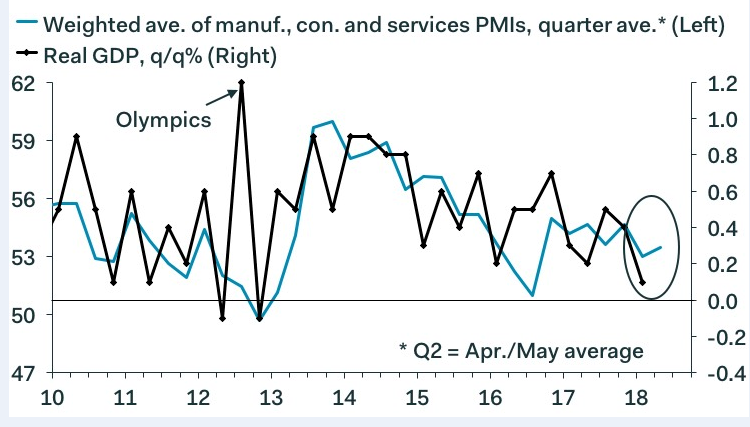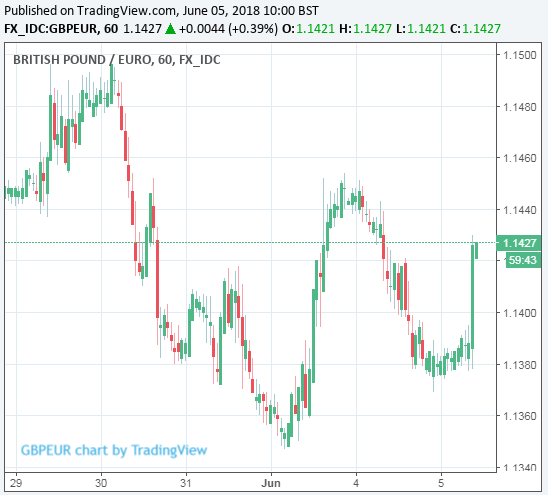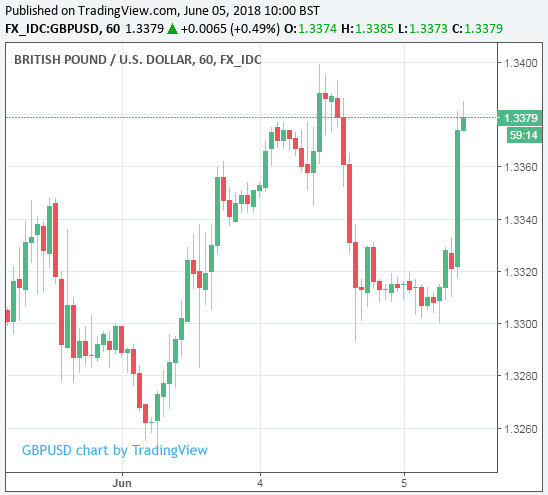British Pound Spikes Higher after IHS Markit Services PMI Surges in May
- Written by: James Skinner
-GBP advances after IHS Markit Services PMI beats expectations.
-Strong rise comes as new orders roll in, bad weather effect fades.
-But "Brexit uncertainty" looms in background once again.

© IRStone, Adobe Stock
The Pound rose sharply against the Euro and Dollar Tuesday as traders responded to the latest IHS Markit services PMI, which showed activity within the UK's largest economic sector rising strongly in May.
May's services PMI came in at 54.0 which, up from 52.8 in April and far ahead of the consensus expectation for a reading of 52.9, marks a continued recovery from the post-referendum low struck back in March when the economy had been hampered by a seasonal slowdown and a period of bad weather.
IHS Markit attributed the increase to the effects of earlier bad weather, in late February and early March, having faded and to a strong pickup in new work orders. Respondents to the survey themselves noted that competitive pricing strategies, greater business investment and succesful product launches were behind improved sales volumes during the period.
"May’s services report increases our conviction that GDP growth will recover in Q2 following weather-related weakness in Q1," says Samuel Tombs, chief UK economist at Pantheon Macroeconomics. "The weighted average of the manufacturing, construction and services PMIs in Q2 so far is consistent with only a 0.3% quarter-on-quarter rise in GDP. But the PMIs didn’t fully capture the slowdown in Q1, so they probably are understating the subsequent rebound."

Above: Pantheon Macroeconomics graph showing UK GDP growth and all-sector PMI.
The services PMI measures changes in industry activity by asking respondents to rate conditions for employment, production, new orders, prices, deliveries and inventories. A number above the 50.0 level indicates industry expansion while a number below is consistent with contraction. It is an important leading indicator of UK economic activity because the services industry accounts for close to 80% of overall gross domestic product.
"May’s Markit/CIPS report on services suggests that the sector has shaken off its weakness at the start of the year," says Ruth Gregory, an economist at Capital Economics. "What’s more, the forward-looking indicators of the survey were fairly encouraging. The new orders index picked up a little in May and the small rise in the employment index also suggests that firms remain confident enough in the outlook for demand to increase the pace of hiring."
Gregory and the Capital Economics team also say the result is consistent with a rebound in economic growth during the second quarter, although they forecast the UK economy will expand by "around 0.4% or so" for the period.

Above: Pound-to-Euro rate shown at hourly intervals.
The Pound was quoted 0.31% higher at 1.3356 against the Dollar following the release while the Pound-to-Euro rate was 0.21% higher at 1.1405.

Above: Pound-to-Dollar rate shown at hourly intervals.
Tuesday's data follows similar surveys of the manufacturing and construction industries, both of which suggested the economy is recovering from a first-quarter slowdown that saw GDP growth fall to just 0.1%, down from 0.4% in the final three months of 2017.
It also comes after a week that saw fears over the stability of the Eurozone and of a so called trade war become resurgent, and as the UK government prepares for a series of Brexit-related votes in parliament that could either advance the UK's journey toward an EU-exit, or threaten an end to Theresa May's reign as Prime Minister.
"The scope for the pound to rebound in the near-term is likely to remain capped by unfavourable Brexit developments in the month ahead. It appears increasingly unlikely that much progress will be made at the upcoming EU Leaders’ Summit," says Lee Hardman, a currency analyst at MUFG. "The votes will be seen as an important test of the government’s ability to pass their Brexit plans later this year. Brexit uncertainty is set to be a weight on the pound this month."
A smooth Brexit process and recovery in growth will be key to rejuvinating UK inflation and interest rate expectations during the months ahead. Pricing in interest rate derivatives markets currently implies there is a less-than 20% probability of a UK interest rate rise in August.
This is a deterioration from the situation that existed at the beginning of April, when the implied probability of a rate hike having been announced by the August 02 Bank of England (BoE) meeting was more than 80%, which owes itself to a faster than expected fall in the rate of UK inflation during 2018 and economic weakness at the start of the year.
"We continue to think that GDP is on track to increase by 0.4% in Q2. This slightly above-trend rate, alongside a pick-up in inflation in June, likely will convince the MPC to hike interest rates in August, provided Brexit doesn’t throw a wrench in the works before then," says Tombs at Pantheon Macroeconomics.
Both Capital Economics and Pantheon Macroeconomics said Tuesday the services rebound, assuming it helps lift growth in the second quarter, will mean an August interest rate rise becomes a bit more likely.
Advertisement
Get up to 5% more foreign exchange by using a specialist provider to get closer to the real market rate and avoid the gaping spreads charged by your bank when providing currency. Learn more here




